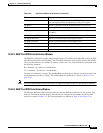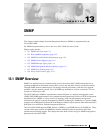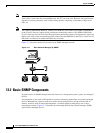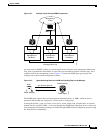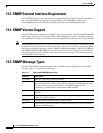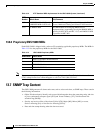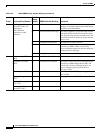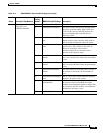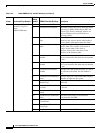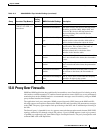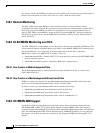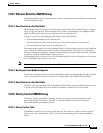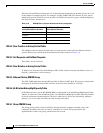
13-7
Cisco ONS 15600 Reference Manual, R7.2
Chapter 13 SNMP
13.7.1 Generic and IETF Traps
13.7.1 Generic and IETF Traps
Table 13-4 contains information about the generic threshold and performance monitoring MIBs that can
be used to monitor any network element (NE) contained in the network. The ONS 15600 supports the
generic IETF traps listed in Table 13-4.
13.7.2 Variable Trap Bindings
Each SNMP trap contains variable bindings that are used to create the MIB tables. Variable bindings for
the ONS 15600 are listed in Table 13-5. For each group (such as Group A), all raps within the group are
associated with all of its variable bindings.
Table 13-4 ONS 15600 Generic Traps
Trap From RFC No. MIB Description
coldStart RFC1213-MIB Agent up, cold start.
warmStart RFC1213-MIB Agent up, warm start.
entConfigChange RFC2037/
ENTITY-MIB
The entLastChangeTime value has changed.
Table 13-5 15600 SNMPv2 Trap Variable Bindings
Group Associated Trap Name(s)
(Variable
Binding
Number) SNMPv2 Variable Bindings Description
A dsx1LineStatusChange
(from RFC 2495, not
applicable to
ONS 15600 but
applicable to other
platforms)
(1) dsx1LineStatus This variable indicates the line status of the
interface. It contains loopback, failure, received
alarm and transmitted alarm information.
(2) dsx1LineStatusLastChange The value of MIB II's sysUpTime object at the
time this DS1 entered its current line status
state. If the current state was entered prior to the
last proxy-agent re-initialization, the value of
this object is zero.
(3) cerentGenericNodeTime The time that an event occurred.
(4) cerentGenericAlarmState The alarm severity and service-affecting status.
Severities are Minor (MN), Major (MJ), and
Critical (CR). Service-affecting statuses are
Service-Affecting (SA) and Non-Service
Affecting (NSA).
(5) snmpTrapAddress The address of the SNMP trap.



